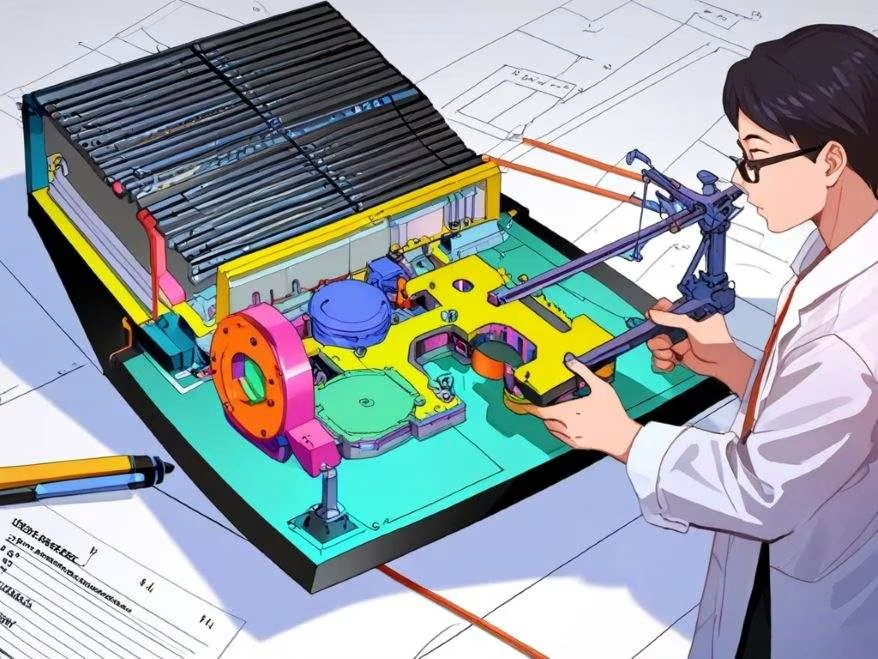Materials Science and Engineering Drives the Future: From Stone Axes to Quantum Dots
The current century is precisely recognized as a “Materials Century”. Because every great leap in human history begins with a material. Our ancestors, though unwittingly, laid the foundation of civilization when they chiseled stone into tools. Since then, scientists and engineers have made tremendous progress in discovering new materials. Ranging from conventional ferrous and non-ferrous alloys to the latest advanced functional materials. Further, we will explore how materials science and engineering have propelled human civilization forward. Also, where will they take us next.

If we fast-forward it to 2025, the quantum dots are now being introduced after manipulating the material at the atomic level for ultra-efficient solar cells. While the nature-inspired 3D printed biomaterials mimic the human tissues. Above all, 4D printed smart intelligent materials can detect/sense the damage, take preventive action, and heal the damage. Therefore, materials are the silent architects of civilization and unsung heroes of progress, bridging our past and future.
A Historical Timeline of Materials and Civilizations
Human civilization has long shaped its history through materials. It’s apt to say, “The story of humanity is written in materials.” This becomes clear when we consider how each era introduced transformative innovations. Early humans used stone to craft axes and harness fire; the Bronze Age introduced alloys for weapons and art. The Iron Age revolutionized agriculture and improved human welfare. Roman engineers built concrete aqueducts that still stand today. Medieval blacksmiths forged Damascus steel into swords of legendary strength. Today, scientists develop advanced functional materials with remarkable breaking strength that are revolutionizing next-generation electronics. All the above materials and their discovery in respective ages laid the fact that materials didn’t just solve the problems. But rather, they reshaped cultures, economies, and empires.
The industrial revolution brought us steel and plastics, while the 20th century gave us semiconductor chips and carbon fibers. Furthermore, a well-known example is Dr. Sossina Haile’s work on solid-state Ionics that further revolutionized the fuel cell. In the present day, we engineer materials with atomic precision.
Revolutionizing the Present: Materials at the Atomic Scale
Thanks to Prof. Andre Geim and Prof. Novoselov, who invented graphene. A 2D material having one atom thickness and a modulus 3 orders more than steel. Such breakthroughs epitomize the 21st-century materials revolution.
During this material’s revolution, materials scientists performed numerous experiments to evaluate their properties. Therefore, it takes several years to develop a new material. One important question to be posed at this juncture is, in the present scenario. Do we have some tools that can predict the properties and eventually the performance of materials before actually fabricating them? Thanks to computational simulations and artificial intelligence (AI) tools. With the help of simulation software and different AI tools, we have moved from trial-and-error experiments to predicting their properties. Indeed, before their discovery or fabrication. Some common discoveries with such simulations are self-healing polymers, shape-memory alloys, and perovskite solar cells. That further exemplifies the present precision-driven era.
Materials in Everyday Life: From Blue Jeans to Smartphones
Materials don’t build just objects rather they build identities. One common example of this is blue jeans. Initially, blue jeans were born from rugged cotton twill and became a global symbol of rebellion. The crystal guarded by Venetian glassmakers is another case that corroborates the above belief. Therefore, it is said that “Materials weave themselves into our art, rituals, and daily lives”. They witness human creativity, from Gothic cathedrals to the carbon composites in modern aircraft.
Modern life swims in a sea of engineered materials. The morning routine itself involved hydrated silica in your toothpaste, nylon toothbrush bristles, followed by stainless steel coffee mugs. The next thing you require is your cell phones. Look around the gorilla glasses of your cell phones. They possess excellent fracture strength. The carbon fibre chairs that you usually sit in and the lithium-ion batteries in your cell phones and earbuds. Scientists and engineers treat each material you use as a marvel of science. Continuously optimizing it for engineering performance, functional properties, cost, and sustainability. Even the most important element for human life to survive nowadays is filtered with advanced polymers in HVAC systems.

Shaping the Future: Materials That Solve Global Challenges
Materials often dictate what’s possible. For example, radiation shielding composites are gaining significant attention to determine whether we can colonize Mars. The exceptional surface activity of silver nanoparticles makes them suitable for triggered release. Also, controlled drug delivery applications in treating Cancer and Alzheimer’s. Where resource dwindles, materials science and engineering offer hope. Lab-grown diamonds are now replacing conflict minerals. The materials community is extensively working on enzymes that can recycle plastics infinitely.
The message is clear: design materials that are abundant, recyclable, and low-carbon emitting. Government and industries are facilitating attractive funding for such sustainable solutions. On this front, the U.S. Materials Genome Initiative supports the research in materials discovery via AI. Also, the European Union funds for graphene or 2D materials-based next-generation electronics. A big player from private giants such as Tesla invests and facilitates huge funding in silicon-anode batteries. The above-mentioned agencies invest an attractive amount of funds for research in materials science and engineering. Thus, considering the pressing problems of the current century.
For instance, perovskite solar cells with 30% efficiency can resolve the climate change issue to a greater extent. Furthermore, biodegradable magnesium stents that are dissolved harmlessly post-surgery can solve the current challenges related to healthcare and biocompatible materials. Solid-state batteries can offer safer and longer-lasting operation in energy storage applications. This eventually indicates that the materials are no longer passive. Moreover, they are actively enabling sustainability, health, and technological leaps.
Opportunities and Challenges Ahead
As mentioned above, several pressing issues need to be addressed on a priority basis. Challenges always come with ample opportunities. The career for recent materials science and engineering graduates spans from battery materials to sustainable biomaterials. Also, smart and intelligent materials, advanced composites, quantum computing, alloy development, and AI-driven materials discovery create limitless pathways. Yet progress isn’t without hurdles. There is still strong demand for e-waste recycling. Rare earth elements like neodymium are geopolitical flashpoints. Some key questions to address at this juncture are: Who will benefit from advanced materials? How do we ensure equitable access?
Famous materials scientist Britt Moser, understanding matter is understanding existence itself.

Conclusion
Materials science and engineering have been a civilization’s compass, from the first stone tool to the most recent lab-grown organs. In the present materials century, as a materials scientist, we should always strive to engineer such a material. That is not just smarter but also induces a wiser relationship with human society. The material that honors the past while safeguarding our future. In conclusion, “Materials are more than substance; they are the DNA of human progress”.
References
- Ago, H., Okada, S., Miyata, Y., Matsuda, K., Koshino, M., Ueno, K., & Nagashio, K. (2022). Science of 2.5 dimensional materials: paradigm shift of materials science toward future social innovation. Science and Technology of Advanced Materials, 23(1), 275–299. https://doi.org/10.1080/14686996.2022.2062576
- Sharma, A. K., Ramacharyulu, D. A., Lakhanpal, S., Shakier, H. G., Reddy, U., & Kumari, V. (2024). Exploring the Future of Advanced Materials Processing: Innovations and Challenges Ahead: A review. E3S Web of Conferences, 505, 01021. https://doi.org/10.1051/e3sconf/202450501021
- Wood, J. (2008). The top ten advances in materials science. Materials Today, 11(1–2), 40–45. https://doi.org/10.1016/s1369-7021(07)70351-6
Additionally, to stay updated with the latest developments in STEM research, visit ENTECH Online. Basically, this is our digital magazine for science, technology, engineering, and mathematics. Furthermore, at ENTECH Online, you’ll find a wealth of information.


